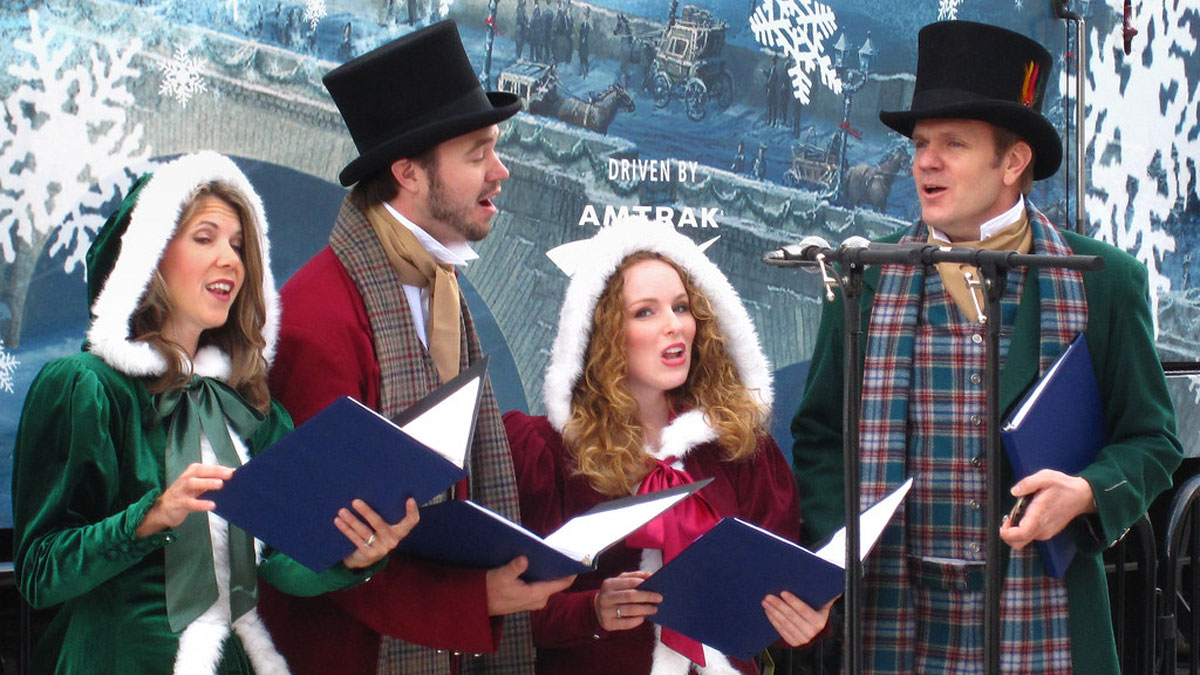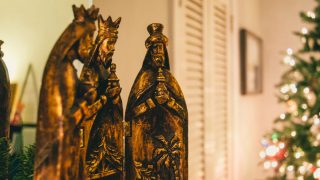Christmas carols are deeply rooted in American and British culture. So whenever you hear carolers on your doorstep, you know for sure Christmas has arrived.
Despite a common misconception, caroling isn’t an 18th-century invention. It wasn’t always as peaceful either.
Caroling was initially known as wassailing, a practice that started in pagan times with an entirely different purpose.
It acquired a more familiar to us form only in medieval times, yet still had some critical distinctions.
Nativity hymns sung in churches originated in the 4th century and were developing parallelly with wassailing.
But it wasn’t until the 18th century that wassailing and Nativity hymns blended, creating the modern version of caroling.
Today, caroling is one of kids’ favorite Christmas entertainments. Despite its slightly twisted history, caroling never fails to bring in the Christmas spirit and elevate our mood.
Table of Contents [show]
The First Nativity Carols (4th century)
Most of the Christmas carols we sing or hear on our doorstep today were written in the 18th-19th centuries. However, they are far from being the first carols to narrate the story of Christ’s birth.
The first Christmas carols known to historians were presumably written in the 4th century, in ancient Rome. At the very same time, Romans first started celebrating Christmas, replacing pagan traditions with Christian.
One of the first Nativity hymns is called Veni Redemptor Gentium, translating as “Come, Redeemer of the nations.”
It was written by Saint Ambrose, bishop of Milan, and was sung in Roman Empire churches from December 17 through December 24.
Veni Redemptor Gentium wasn’t forgotten over time and became especially popular in Germany after Martin Luther King translated it to German as “Nun Komm, der Heiden Heiland.” The hymn is still often performed in Italian and German churches.
In the 9th century, Central and Northern European bishops started developing more Christmas hymns, such as Veni Creator Spiritus written by German archbishop Rabanus Maurus and based on the first-ever hymn Veni Redemptor Gentium.
Although these hymns told the story of Jesus’ birth and were sung throughout the Christmas season, they were still very different from modern carols.
If you consider church masses boring, try to imagine a mass in the Middle Ages. Everything was sung in Latin, which neither of the regular people could understand.
In the 12th century, Parisian monk Adam of Saint-Victor came up with the idea of deriving music from popular at that time songs and combining it with already known Nativity hymn lyrics. These Christmas hymns were much closer to what we know as carols today.
Throughout the 13th century in France, Italy, and Germany, Christmas songs began to be sung by ordinary people in regional languages on the streets and at homes, not solely in churches.
The first Christmas carols in the English language were written in 1426 by John Alay. He created a list of 25 carols that were sung by house-visiting wassailers – the original carolers.
Many modern Christmas carols, such as Good King Wenceslas and Christ Was Born on Christmas Day, were initially written in Latin in medieval times. Their early versions can be found in the 16th-century book Piae Cantiones.
Wassailing: the Origin of Caroling
Long before the first Nativity hymn was written, Celtic Druids were participating in a wassailing ceremony during winter solstice festivals celebrated at the end of December.
Wassailing involved singing to cider apple trees in orchards to please pagan gods, ward off evil spirits, and attract a good harvest. In fact, this tradition is still widely observed in some parts of Britain.
In medieval times, however, orchard wassailing transformed into house-visiting wassailing. Britain at that time had feudal law, and the poor had little to no privileges.
But at Christmas time, servants had more privileges than on any regular day. Fun fact – the same practice was common Ancient Roman Empire during the first Christmas celebrations when the poor could feast together with the nobles.
In other words, at Christmas time, people of all social classes were seen as equal. Servants visited homes of their feudal lords, singing Nativity songs and demanding money or food.
The most popular wassailing song of that time, Here We Come A-wassailing, is still sometimes sung today.
“Demanding” is not an exaggeration. Wassailers wouldn’t go away until the feudal lord complied with their demands and expressed his goodwill.
If the lord refused, wassailers could vandalize the property. But if he gave them what they asked for, he would receive blessings.
The feudal system came to an end in the 16th century. The wassailing tradition, however, was preserved. Instead of visiting feudal lord homes, people started visiting houses in their neighborhood.
Caroling Ban
Not long after the feudal system was diminished, the Protestant Reformation started. In the 17th century, Christmas celebrations were seen as desacralizing for such an important religious holiday.
Many Christmas traditions were banned at that time. According to Protestant convictions, Christmas, in general, was a holiday for sinners and should not have been observed.
Protestants considered wassailing a justification for home invasions and drinking, which was partially true.
Wassailing indeed involved consuming large amounts of alcohol, which resulted in drunken crowds roaming the streets at Christmas time, participating in all sorts of debauchery.
And so, wassailing was banned. By the 18th century, Christmas celebrations moved from the streets to homes and became much quieter.
How Wassailing Transformed into Caroling
When the Protestant rule came to an end, British people began reviving Christmas traditions, though many of them changed drastically. People yet again started visiting homes of their neighbors and friends, singing Christmas songs.
However, the post-reformation version of wassailing didn’t involve drinking (at least in such large amounts) and was much friendlier. These new wassailers didn’t make demands either – they saw a different purpose in this tradition.
Pos-reformation wassailers were singing hymns to share holiday cheer and good blessing with everyone around, not to get money. However, they still often received some food or drink as a sign of gratitude.
That’s how wassailing turned into caroling. The distinction between these two customs is quite vague. The main difference between wassailing and caroling is the lack of demands and property vandalizing in caroling.
Carolers had to come up with different hymns to showcase their good intent. The traditional Here We Come A-Wassailing didn’t really fit the context. Although it mentioned good blessings, it also involved quotes as:
“Bring us out a table and spread it with a cloth; Bring us out a moldy cheese and some of your Christmas loaf,” followed by “we won’t go until we’ve got some.”
The Rise of Christmas Carol
The shift from wassailing to caroling pushed people to start creating new Christmas songs. The 18th century was the rise of the Christmas carol as we know it today. Many of the most popular Christmas carols were written at that time.
So, the famous Holy Night, Silent Night, was created in 1816 by a young Austrian priest Joseph Mohr. It was initially written in German as Stille Nacht Heilige Nacht and translated to English a century later.
Another popular Christmas carol, God Rest You Merry, Gentlemen, was written much earlier – likely in the 16th century. It has undergone numerous lyric changes until carolers adopted it as a tradition.
The reason for the popularity of God Rest You Merry, Gentlemen, is Charles Dicken’s famous story A Christmas Carol.
When the book’s main character Scrooge Ebenezer hears, “God bless you, merry gentlemen! May nothing you dismay!” he quickly locks the door to avoid talking to carolers.
Many Christmas carols of that era narrated the Nativity story.
We Three Kings, for instance, tells the story of the Three Wise Men who visited Jesus with gifts right after he was born. The First Noel lyrics state: “Noel, Noel, Noel, Noel, Born is the King of Israel.”
Some Christmas carols weren’t initially intended as such. O Little Town of Bethlehem is known as a Christmas carol commemorating Christ’s birth, though it was originally a folk song about a dead ox.
The lyrics were changed only in the 19th century, and the carol quickly became a timeless classic.
Twelve Days of Christmas, in turn, originated as a children’s memory-and-forfeit game. The carol’s lyrics revolve around a series of increasingly numerous gifts given throughout the Twelve Days of Christmas.
The most published Christmas carol in Northern America is Joy to the World, written in 1719 by Isaac Watts. The lyrics are based on Biblical psalms, celebrating Christ’s second coming more than the first.
Caroling Today
At the end of the 17th century, caroling was brought to America by British colonists. Over the centuries, it became deeply incorporated into American culture.
In the modern days, caroling is a common Christmas tradition in the US, Britain, and Ireland. In the British Isles, caroling is mainly a children’s activity, often involving charity.
According to Pew Research Center, about 16% of Americans go caroling in adult age, and 36% used to go caroling as kids.
The tradition, however, is seeing a steep popularity decline. Famous 18th-century Christmas carols are being replaced with modern 20th-century Christmas songs, and many people view visiting others’ houses as an invasion into personal space.






















